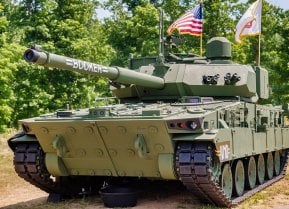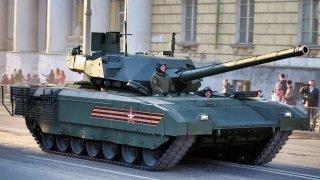Russia's T-14 Armata Tank Nightmare Has Just Begun
Summary: The ambitious T-14 Armata program, once hailed as the future of Russian armored warfare, faces significant setbacks and unmet expectations. Initially planned for a massive rollout of 2,300 units from 2015 to 2020, the reality has fallen short, prompting speculation that the program might be abandoned.
Summary: The ambitious T-14 Armata program, once hailed as the future of Russian armored warfare, faces significant setbacks and unmet expectations. Initially planned for a massive rollout of 2,300 units from 2015 to 2020, the reality has fallen short, prompting speculation that the program might be abandoned. The Armata's troubles began early, notably with a malfunction during its 2015 debut, mirroring the misfortune of Tesla's Cybertruck. Its subsequent withdrawal from frontline service in Ukraine due to underwhelming performance further eroded confidence in the tank's capabilities.
T-14 Armata: Russia's Tank of the Future Faces Uncertain Fate
The Russians were counting on the T-14 Armata as the tank of the future. Initial procurement plans called for 2,300 T-14s to be delivered between 2015 and 2020.
But it’s 2024 and nothing like 2,300 T-14s have been delivered to the Russian Army.
Indeed, the Armata program may never materialize as envisioned, with Sergio Miller arguing that the “story is over.”
Is the T-14 Armata Story Over?
The T-14 started off on the wrong foot, much like Tesla’s Cybertruck, breaking during its unveiling at the 2015 Victory Day parade, with thousands of witnesses. According to Miller, the breakdown was an “augury,” and that now, almost one decade later, “it can be stated with confidence the Armata story is over.”
So, where did the T-14 program go wrong?
Technically, the Armata is still Putin’s tank of the future. But the program has been consistently hampered, for a long time now. Making matters worse, last September, the Armata was pulled from frontline service in Ukraine, indicating that the new tank’s performance was suboptimal.
“Armored forces from Russia’s southern military district (SMD) were given T-14 “Armata” main battle tanks (MBTs) for combat operations, according to the state news agency Tass, which noted that this was Moscow’s first official confirmation of their use in Ukraine,” Newsweek reported.
According to one military source, the Armata was used in combat operations and several units participated in battle to gauge the tank’s performance. Shortly thereafter, the tanks were pulled from the frontline. The inference of course is that the Armata performed poorly.
Now, the T-14’s withdrawal from Ukraine does not mean conclusively that the program is being canceled. But the fact that Russia was not comfortable using their “tank of the future” in a land-based war of attrition speaks volumes to the (lack of) confidence Putin has in the Armata. (Granted, Russia is suggesting that the tank is too valuable to use in war).
The T-14 was supposed to offer a boost for the beleaguered Russians; the tank was highly anticipated and expected to help the cause. The tank’s 125mm cannon and supposed high survivability features were long awaited. The Russians are undoubtedly keen to improve the survivability of their soldiers.
Russian casualties have been remarkably high. To date, Moscow is believed to have lost 424,060 troops. In the past week alone, Russia lost 7,200 troops, 278 artillery systems, and over 200 armored personnel vehicles. Russia has also lost nearly one hundred tanks in the past week. So, an infusion of fresh tanks is becoming increasingly necessary.
T-14: The Source of the Problem
Miller believes that the Armata’s primary problem lies with the engine, in large part because the tank was designed around an engine rather than the other way around. What happened is that Uralvagonzavod (UVZ) decided to use the A-85-3 engine as the basis for the Armata. However, the A-85-3 was complex and extremely difficult to maintain, causing practical problems. The Russians could have perhaps solved the problem with a swap – the A-85-3 for the proven and more durable V-92S2F engine. Yet, the 92S2F was too big for the T-14, which was built strictly to accommodate the smaller A-85-3.
“The only realistic engineering solution now is to start again,” Miller said.
About the Author: Harrison Kass
Harrison Kass is a defense and national security writer with over 1,000 total pieces on issues involving global affairs. An attorney, pilot, guitarist, and minor pro hockey player, Harrison joined the US Air Force as a Pilot Trainee but was medically discharged. Harrison holds a BA from Lake Forest College, a JD from the University of Oregon, and an MA from New York University. Harrison listens to Dokken.
Image Credit: Creative Commons.


